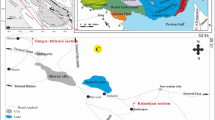Abstract
During the 50th cruise of R/V Akademik Mstislav Keldysh, on the south slope of the Atlantis massif (30°07′N; the Middle Atlantic Ridge), an inactive hydrothermal field named the Lost Village was discovered. This new field was formed of light carbonate rock and was located near the active Lost City hydrothermal field. The mineralogical associations of these fields were studied. A conclusion about the participation the ocean water in the changing of the carbonate composition of the inactive hydrothermal field was reached.
Similar content being viewed by others
References
A. V. Dubinin, Geokhimiya redkozemel’nykh elementov v okeane (Nauka, Moscow, 2006) [in Russian].
O. E. Dubinina, I. V. Chernyshov, and N. S. Bortnikov, “Isotopic-Geochemical Characteristics of the Lost City Hydrothermal Field” Geokhimiya, 45(11), 1223–1236 (2007) [Geochem. Int. 45 (11), 1131–1143 (2007)].
A. Yu. Lein, S. V. Galkin, V. V. Maslennikov, et al., “New Type of Carbonate Rocks on the Ocean Bottom (Mid-Atlantic Ridge, 30°07′N),” Dokl. Akad. Nauk 412(4), 535–539 (2007).
A. Yu. Lein, Yu. A. Bogdanov, A. M., et al., “White Towers of the Lost City,” Priroda (Moscow, Russ. Fed.), No. 12, 40–46 (2002).
A. Yu. Lein, Yu. A. Bogdanov, A. M. Sagalevich, et al., “New Type of a Hydrothermal Field on the Mid-Atlantic Ridge (the Lost City Field, 30°N),” Dokl. Akad. Nauk 394(3), 380–383 (2004).
D. Yu. Pushcharovsky, Radiography of Minerals (Geoinformark, Moscow, 2000) [in Russian].
N. V. Turanskaya and T. G. Kuz’mina, “Method of XRay Fluorescence Analysis of Bottom Sediments,” Okeanologiya 18(6), 1110–1114 (1978).
D. E. Alleu and W. E. Seyfried, Jr. “Serpentinization and Head Generotion: Constraints from Lost City and Rainbow Hydrothermal System,” Geochem. Cosm. Acta 68(6), 1347–1354 (2004).
H. Elderfield and A. Schulth, “Mid-Ocean Ridge Hydrothermal Fluxes and the Chemical Composition of the Ocean,” Ann. Res. Earth Planet. Sci. 24, 191–224 (1996).
S. V. Galkin, “Lost Village—a “Faubourg” of Lost City: Benthic Using Gir Submersibles at North Atlantic Hydrothermal Sites in 2005,” InterRidge News 15, 18–24 (2006).
S. V. Galkin, N. E. Budaeva, O. E. Kamenskaya, and D. N. Zasko, “Lost Village in Suburbs of Lost City: New Evidences about Bottom Fauna at Off-Axis Hydrothermal Vents,” in Proceedings of the 11th International Deep-Sea Biology Symposium, Southampton, United Kingdom, July 9–14, 2006 (2006), p. 99.
G. L. Früh-Green, D. S. Kelley, S. M. Bernasconi, et al., “30000 Years of Hydrothermal Activity at the Lost City Vent Field,” Science 301, 495–498 (2003).
D. S. Kelley, J. A. Karson, D. K. Blackman, et al., “An Off-Axis Hydrothermal Vent Field Near the Mid-Atlantic Ridge at 30°N,” Nature 412, 145–149 (2001).
Author information
Authors and Affiliations
Corresponding author
Additional information
Original Russian Text © O.M. Dara, T.G. Kuz’mina and A.Y. Lein, 2009, published in Okeanologiya, 2009, Vol. 49, No. 5, pp. 742–750.
Rights and permissions
About this article
Cite this article
Dara, O.M., Kuz’mina, T.G. & Lein, A.Y. Mineral associations of the Lost Village and Lost City hydrothethermal fields in the North Atlantic. Oceanology 49, 688–696 (2009). https://doi.org/10.1134/S0001437009050105
Received:
Accepted:
Published:
Issue Date:
DOI: https://doi.org/10.1134/S0001437009050105




